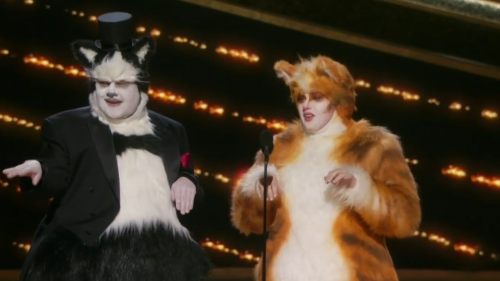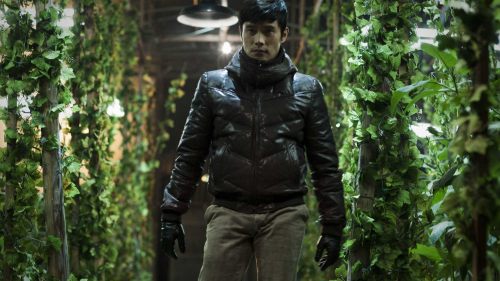Ten Past Makeup Achievements Ignored By Oscar
This morning, the Academy Award nominations brought the usual debate about deserving films and actors who get left out of the running. Further down the list, devotees of the craft of makeup no doubt found some of their 2018 favorites missing in that category. Where, for example, are Mark Coulier’s striking transformations of Steve Coogan and John C. Reilly in Stan & Ollie and Tilda Swinton for Suspiria (which were on the Academy’s shortlist) or Bill Corso’s deglamorizing of Nicole Kidman in Destroyer (which wasn’t)?
Guesses can only be ventured for both: The dual possibilities for Coulier (who discusses his Suspiria work here) must have canceled each other out—a real shame, given his sterling work on both. And with Destroyer, the Lola Visual Effects company contributed some digital de-aging wizardry to Kidman for the flashback scenes, and the committee has a history of frowning on other crafts infringing on theirs (more on that shortly…).
This isn’t the first time odd choices and omissions have been made in the Best Makeup category (updated to Best Makeup and Hairstyling in 2012); the original Batman’s Joker wasn’t even nominated, but Suicide Squad’s won. Those mourning the snubbing of Stan & Ollie, Suspiria, Destroyer or other worthy contenders can console themselves that these past films also missed out on even getting nominated for makeup Oscars.

The Thing
Beyond the vicious reviews and paltry box office that greeted John Carpenter’s masterpiece upon its first release, its fate in this area was sealed within a week of its opening, when the Make-up and Hair Stylists Local 706 union won a legal judgment against Universal over Rob Bottin’s credit on the film for “special make-up effects.” An arbitrator agreed with the union’s attorney that Bottin’s contributions consisted of “mechanical devices, mannequins and non-living things” that did not qualify as makeup because they were not applied to live actors. The union got $10,000 in damages, adding insult to the film’s financial injuries. Needless to say, the Academy chose not to honor The Thing, instead nominating Quest for Fire (which won) and Gandhi.

Tootsie
Here, on the other hand, is an inexplicable snub from the same year. Making up a character who hides in drag poses a special challenge for any artist: not only does the subject need to look right to the audience, but the audience has to believe that the other characters think he is a she or vice versa. When Dustin Hoffman’s struggling actor Michael Dorsey disguises himself as “Dorothy Michaels” to win a soap-opera role, the illusion created by Hoffman and makeup artists George Masters and Dorothy J. Pearl is flawless, to the point where it’s easy to buy everyone around him responding to him as a woman. (During production, Hoffman reportedly chatted off the set with friends and associates as Dorothy, with no one the wiser.) Tootsie received 10 Oscar nominations, with Jessica Lange taking Best Supporting Actress, but was somehow overlooked in arguably its most crucial craft category. (Fun fact: Pearl began her career on The Texas Chainsaw Massacre, applying blood and rigging a makeshift harness for the Pam-on-a-meathook scene.)

Monty Python’s The Meaning of Life
It has been said that the Best Makeup category was created in part as a response to criticism over the lack of Oscar recognition for Christopher Tucker’s transformation of John Hurt for David Lynch’s The Elephant Man. They had a chance to redress that balance by citing his creation of Meaning of Life’s memorable Mr. Creosote (“Better get a bucket, I’m going to throw up!”), alongside the film’s overall makeup designer Maggie Weston (Terry Gilliam’s wife, later nommed for The Adventures of Baron Munchausen). They didn’t, and it wasn’t a matter of competition; there were no Best Makeup nominees or award at all for ’83, with The Hunger’s Dick Smith also ignored. Tucker literally just couldn’t win with the Academy; he was not acknowledged for his Quest for Fire work either.

Enemy Mine
This saga of soldiers from warring human and alien races (Dennis Quaid and Louis Gossett Jr.) learning to coexist when they’re stranded on a hostile planet had a tumultuous history. After weeks of shooting under director Richard Loncraine, he was replaced with Wolfgang Petersen, who started over from scratch. Part of that process involved an overhaul of the makeup on Gossett’s “Drac” character, which reportedly took five months. It was worth it: Chris Walas’ lizardlike prosthetics are a highlight of the film, though its ultimately disastrous box-office reception no doubt helped keep it out of the nominating committee’s orbit (which instead encompassed The Color Purple, Remo Williams: The Adventure Begins and the winner, Mask). Walas wouldn’t have to wait long for recognition, though; he won the following year for his grotesqueries in David Cronenberg’s The Fly.

Platoon
The British Film Institute announced last November that it would no longer fund movies with facially scarred villains, out of sensitivity to real people with such differences. While this trope has certainly been used as easy shorthand in some cases, it must also be said that its application in others has done a lot to visually evoke a history for the character. There’s no better example than Tom Berenger’s Staff Sergeant Barnes in Oliver Stone’s Vietnam drama: one look at the deep wounds crossing his face, and you know right away where his calcified views on warfare stem from. Given that Platoon was the Oscar champ of its year, it’s inconceivable that Gordon J. Smith, credited with “special makeup effects and visual continuity,” didn’t at least get a nomination for his flawless work. Yes, there was tough competition that year from The Fly and Legend, but surely Platoon could have been cited in favor of the third nominee, The Clan of the Cave Bear. Smith’s bizarre sights for the later Jacob’s Ladder didn’t get a nod either.

Requiem for a Dream
Before announcing The Fly’s victory and its fellow nominees, presenter Rodney Dangerfield quipped, “Makeup is important. In movies, everybody wants to look good, you know? And who always wins the award? The guy who creates the ugliest creature there is.” That contradiction hasn’t often extended to artists who make actresses look their worst, however. One notable case is Darren Aronofsky’s drug-addiction drama, in which Vincent J. Guastini physically affected the diet-pill dissolution of Ellen Burstyn’s Sara Goldfarb. Her descent into emotional and physical hell is tough to watch—as are Guastini’s other Requiem creations, like the amputation of Harry’s (Jared Leto) arm—which may be why the Academy instead chose to recognize The Cell, Shadow of the Vampire and the eventual victor, How the Grinch Stole Christmas.

Planet of the Apes
Rick Baker is by far the most Oscared makeup artist in history, with seven wins off eleven nominations. He’s the undisputed master of creating movie gorillas, nommed for Greystoke: The Legend of Tarzan, Lord of the Apes and as part of the Visual Effects team on Mighty Joe Young. Thus, it’s puzzling that he was overlooked for the exceptional simian community he crafted for Tim Burton’s revisiting of the 1968 classic. All of the films in the more recent rebooted Apes trilogy got Best Visual Effects noms as well, which makes it even odder that Baker couldn’t place alongside The Lord of the Rings: The Fellowship of the Ring (which won), A Beautiful Mind and Moulin Rouge!

Monster
When Charlize Theron took to the stage to accept her Best Actress Oscar for Patty Jenkins’ standout drama, she thanked Toni G. “for transforming me so incredibly” into serial killer Aileen Wuornos. Remarkably, that metamorphosis was achieved without prosthetics, other than dentures, with Toni G. (a supervisor on Baker’s Apes team) giving Theron the withered visage of Wuornos via hand-painted and airbrushed applications of tattoo ink and other kinds of liquid makeup. Her detailed, textured visage holds up to scrutiny in the tightest close-ups, but that apparently wasn’t enough in the year that saw The Lord of the Rings: The Return of the King (the victor), Master and Commander: The Far Side of the World and Pirates of the Caribbean: The Curse of the Black Pearl nominated. Perhaps if the film had a subtitle?

Tropic Thunder
Baker scored a nom for Coming to America, in which the multiple roles he helped Eddie Murphy disappear into included an old white Jewish man, but apparently his putting Robert Downey Jr. into blackface was too much for the Academy. He was part of the short list but didn’t make it to the final three, which turned out to be The Dark Knight, Hellboy II: The Golden Army and winner The Curious Case of Benjamin Button. Downey himself got a nomination for playing Australian Method actor Kirk Lazarus (who has undergone “pigmentation alteration” for his latest role), and some felt Tom Cruise deserved one too as bald, obese and hairy studio chief Les Grossman, while the man who altered their appearances so drastically was left out.

The Shape of Water
Superb work here on Doug Jones as the amphibious man by the Legacy Effects team—so why no nomination? Most likely the same reason Destroyer got skunked: the prosthetics were augmented by CGI, and thus the illusion, in the nominators’ eyes, wasn’t “pure” makeup. The same rationale could also explain why It wasn’t nommed the same year, when Darkest Hour (which won), Victoria & Abdul and Wonder were the contenders.



